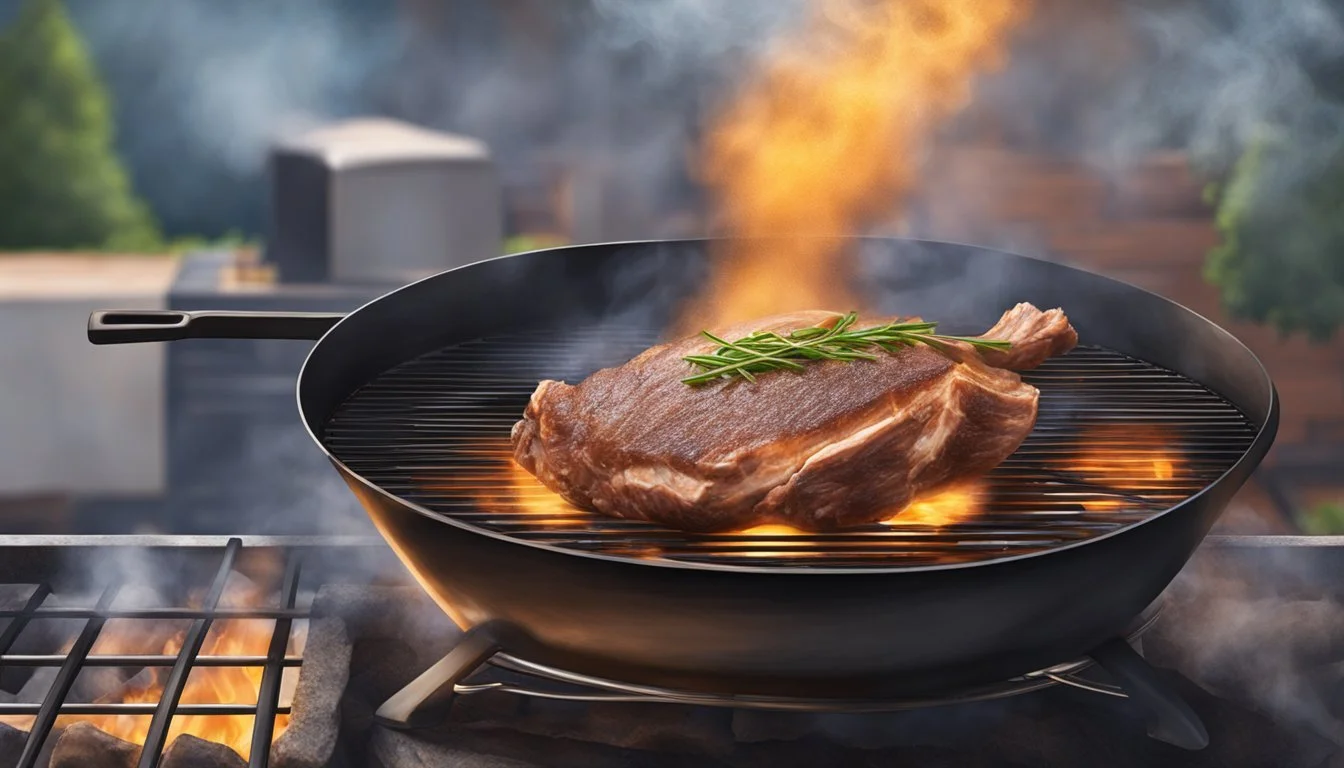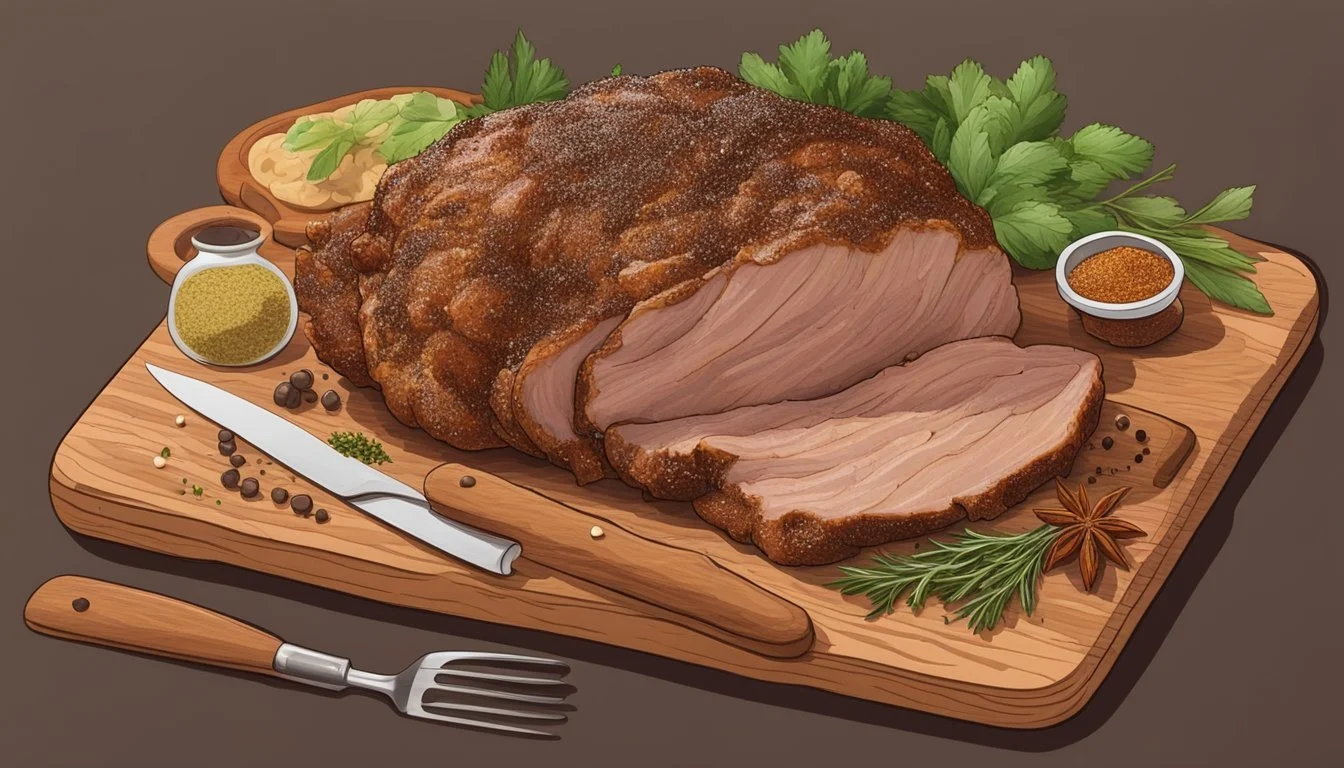Smoking Pork Shoulder
Expert Tips for Perfect Pulled Pork
Smoking pork shoulder is a culinary art that transforms a tough cut of meat into a tender, flavorful delight. The process involves cooking the meat at low temperatures over an extended period, allowing heat and smoke to penetrate deep into the pork. The pork shoulder, also known as pork butt, contains a significant amount of connective tissue, which melts into succulence as the meat slowly cooks. The ideal internal temperature to aim for is around 195 to 205 degrees Fahrenheit, as measured by a meat thermometer; this range signifies that the meat is perfectly cooked for pulling or shredding into tender morsels.
Before the smoking process begins, preparation is key. Starting with a quality cut—often a bone-in pork shoulder for its rich flavor—chefs coat the meat with a rub typically comprising black pepper, garlic powder, (how long does garlic powder last?) paprika, brown sugar (how long does sugar last?), and salt. Some add layers of flavor by slathering the meat in yellow mustard, which acts as a binder for the dry rub, enhancing the bark's formation. Throughout the cooking, maintaining moisture is critical. Spray bottles filled with a mixture of apple cider vinegar and water are frequently employed to mist the meat, keeping it moist and helping to develop a deep, inviting crust.
Choice of wood contributes significantly to the aroma and taste profile of the smoked pork. Woods like hickory, mesquite, apple, or cherry impart distinctive smoky flavors, (What wine goes well with smoky flavors?) turning a simple piece of meat into an aromatic and savory experience. As the pork cooks, it's often wrapped in either butcher paper or aluminum foil—known as the "Texas crutch"—to avoid drying out and to push through the temperature plateau. Once off the heat, the pork must rest, often wrapped in an airtight container or covered in foil, to allow the juices to redistribute. This pause ensures each slice is as juicy and flavorsome as possible, making the smoked pork shoulder a staple for hearty meals and delicious pork sandwiches alike.
Choosing the Cut
Selecting the right pork shoulder cut is essential for achieving a tender, juicy final product after the smoking process. The cut you choose will impact flavor, texture, and cooking time.
Bone-In vs Boneless
Bone-in pork shoulder, often referred to as a pork butt or Boston butt, is preferred by many barbecue enthusiasts for its ability to retain moisture and flavor during the long cook time required for smoking. Bone-in cuts tend to have a higher content of connective tissues, which gradually break down and contribute to the tenderness of the meat. As for cooking temperatures, an internal temperature reaching between 195°F to 205°F is necessary for the collagen within those connective tissues to properly melt, which can be monitored using a meat thermometer. The presence of the bone can also add depth to the smoke flavor profile and is said to contribute to a more evenly cooked piece of meat.
On the other hand, boneless pork shoulder typically comes in a neater, more uniform shape that can be easier to handle and carve. Without the bone, this cut can often cook a bit faster, though it might not achieve the same level of flavor complexity as the bone-in variety. During the smoking process, it's important to maintain proper moisture levels, and boneless cuts may benefit from being wrapped in butcher paper or aluminum foil part-way through the cook to prevent drying out. When considering preparation, simple ingredients such as a rub of black pepper, brown sugar, and garlic powder can be applied directly onto the meat. For added flavor, a spritz of apple cider vinegar and water mixture from a spray bottle during the smoking process can assist in keeping the meat moist and creating a delicious bark.
Preparing the Pork
When smoking a pork shoulder, the preparation involves a series of crucial steps that ensure the meat is seasoned adequately and cooked to the ideal internal temperature for tenderness and flavor.
Trimming Excess Fat
Before seasoning, trim off any excessively thick fat from the pork shoulder, leaving a thin layer that will melt and moisturize the meat during the cooking process. A sharp knife and steady hand ensure that just the right amount of fat is removed to balance the meat's flavor and texture.
Applying a Dry Rub
After trimming, coat the pork butt generously with a dry rub that combines elements such as brown sugar, paprika, black pepper, garlic powder, and a touch of cayenne for heat. For added adhesion, slather the pork with a thin layer of yellow mustard before applying the rub. This will not only help the seasoning stick but also add a subtle tanginess to the meat. The dry rub should form a consistent layer across the meat, providing a flavorful crust known as bark:
Ingredients for Dry Rub:
Brown sugar
Paprika
Black pepper
Garlic powder
Cayenne pepper
Using a Meat Thermometer
During smoking, it's essential to monitor the pork's internal temperature. Insert a digital meat thermometer into the thickest part of the shoulder, avoiding the bone. The target internal temperature for perfectly smoked pork is between 195°F to 205°F. Cooking to the correct temperature ensures the breakdown of connective tissues, resulting in tender and juicy meat.
Creating a Signature Spice Rub
Crafting a signature spice rub is essential in amplifying the flavor of pork shoulder. The right blend will permeate the meat with rich taste and create a delicious crust known as the bark.
Key Dry Ingredients
Creating a potent spice rub begins by selecting high-quality, dry ingredients. Fundamental components include:
Brown Sugar: Adds sweetness and aids in forming the bark.
Paprika: Delivers a smoky flavor and vibrant color.
Salt: Essential for flavor enhancement and moisture retention.
Black Pepper: Contributes a sharp, piquant taste.
Garlic Powder: Provides a savory note.
Onion Powder: (how long does onion powder last?) Offers a subtle, sweet flavor.
Chili Powder: Adds a mild, spicy kick.
Cayenne Pepper: For those who prefer a hotter edge.
Additional options include dry mustard for tanginess or cumin for a warm, earthy note. For achieving the ideal internal temperature during smoking, always keep a meat thermometer handy.
Bringing the Rub Together
To combine these ingredients, follow these steps:
Measure Accurately: Use equal parts of paprika, garlic, and onion powder, and adjust salt, brown sugar, and chili powder to taste.
Mix Thoroughly: Use a fork or whisk to ensure the blend is free of clumps.
Store Properly: Place the rub in an airtight container to maintain freshness and prevent moisture contamination.
When applying the rub, do so generously over the pork shoulder, ensuring a complete, even coat. This can be done up to 24 hours before smoking to allow the flavors to penetrate deeply. Use disposable gloves to keep the process hygienic and to avoid staining your hands with spices.
Preparing the Smoker
Before embarking on the smoking process, the correct preparation of your smoker and the judicious choice of wood will set the foundation for mouth-watering results.
Choosing the Wood
Wood selection is crucial in imparting the desired smoke flavor to pork shoulder. Hardwoods like hickory, oak, or fruit woods such as apple or cherry provide a robust smoke that complements the meat's natural flavors. Typically, fruit woods offer a milder taste while woods like hickory contribute a more intense smoky essence. Bend your choice towards the wood that aligns best with the flavor profile you aim to achieve.
Hickory:
Flavor Profile: Strong, bacon-like
Oak:
Flavor Profile: Medium, smoky
Apple:
Flavor Profile: Mild, sweet
Cherry:
Flavor Profile: Mild, fruity
Setting Up the Equipment
Properly setting up your smoker ensures even cooking and optimal flavor. Begin by cleaning the grill grates and confirming that your smoke box or wood chip tray is adequately filled. For those using a pellet smoker, ensure the hopper is loaded with your chosen pellets. Preheating the smoker to the target smoker temperature—commonly between 225°F and 250°F—is a critical step for consistent cooking. If your smoker has a water pan, fill it to help maintain humidity, keeping the meat moist throughout the cooking time. A meat thermometer should be placed at the grill level to monitor ambient temperature accurately.
When the smoker reaches the desired temperature and produces a steady stream of smoke, it's time to place the pork shoulder on the grates. If you have a spray bottle, fill it with a mixture of apple cider vinegar and water to mist the pork periodically, ensuring it remains hydrated and tender during the long smoking process.
Maintaining the Target Temperature
Achieving and maintaining the appropriate temperature is crucial for smoking pork shoulder, impacting cooking time and ensuring tender meat with the desired smoke flavor.
Ideal Temperature Range
For optimal results when smoking pork shoulder, maintaining a steady smoker temperature between 225°F and 250°F is recommended. This range allows for a slow cooking process that is crucial for melting connective tissues, which contributes to the meat's tenderness. It’s important not to exceed 275°F as higher temperatures can lead to dry pork by forcing the connective tissues to break down too quickly. Consistency in this temperature range is key in creating a perfect environment for rendering fat without compromising the moisture of the meat.
Low and slow: Use a pellet smoker or charcoal grill to sustain a controlled, even heat during the entire time.
Types of wood: Select woods like pecan, hickory, cherry, or apple to provide a smoky flavor that complements pork.
Monitor regularly: Check the smoker temperature every hour, adjusting the pellet grill settings or air vents of the charcoal grill as necessary.
Monitoring Internal Temp
The goal internal temperature for perfectly smoked pork shoulder is between 195°F and 205°F. To check this, insert a meat thermometer into the thickest part of the meat without touching the bone.
Initial check: Begin testing after the pork has smoked for approximately one hour per pound.
Proper equipment: Use a reliable digital meat thermometer for accurate readings.
Resting time: After reaching the desired internal temperature, let the pork shoulder rest wrapped in butcher paper or foil for 30-60 minutes, which allows juices to redistribute.
Maintaining control over the smoker temperature and carefully monitoring the internal temperature of the pork are integral steps in crafting a delicious, tender pork shoulder perfect for sandwiches, tacos, or enjoying with your favorite barbecue sauce.
The Low and Slow Smoking Process
The low and slow smoking process accentuates the rich flavors of pork shoulder, transforming it into a tender and succulent meal. With meticulous attention to cook time, internal temperature, and resting, you can achieve the perfect balance of smoky flavor and juicy tenderness.
Estimating Cook Time
Your pork shoulder's size and the smoker's temperature primarily dictate the cook time. For smoking at 225°F, it's common to allocate about 90 minutes per pound. In cases where the smoker is set for 275°F, cook time can be expected to be approximately 6-8 hours. For instance, a 10-pound pork butt at 225°F would take around 15 hours, whereas at 275°F, the same cut might take closer to 8 hours.
Testing Doneness
To ensure tender pork, monitoring internal temperature is critical. Aim for an internal temperature of 195°F to 201°F—this range guarantees that the connective tissues have broken down sufficiently. The meat's doneness is best assessed using a meat thermometer plunged into the thickest section without touching the bone. The meat should also display a nice mahogany color and the bone should wiggle free with little resistance.
Letting Meat Rest
Post smoking, it is essential to let the meat rest for usually 30-60 minutes. Wrap the pork shoulder in butcher paper or aluminum foil and place it in an airtight container, like a cooler without ice, to conserve heat. Resting lets the juices redistribute throughout the meat, ensuring that every bite is flavorful and moist. After resting, unwrapping the pork will reveal if it's ready to be pulled; at this stage, tools like meat claws or disposable gloves can be used to shred the pork into desired sizes for meals like pork sandwiches or tacos.
Shredding and Slicing the Pork
When smoking pork shoulder, the final steps of shredding and slicing are crucial to serving tender and flavor-packed meat. Whether pulled apart for sandwiches or sliced for a plated meal, proper technique ensures a delectable presentation.
Pulling Apart the Meat
After the pork shoulder has achieved the desired internal temperature of 195° to 205° F, it should rest for at least 30-60 minutes. This allows the juices to redistribute and connective tissues to relax, making the meat tender and easier to pull apart. To shred the meat, use clean meat claws or disposable gloves to handle the hot pork. Gently pull the meat into pieces, removing any excessively fatty or sinewy parts. If the meat resists shredding, it may need more time to cook, as only well-cooked pork will shred easily.
Trimming Excess Fat
Trimming should be done pre-cook, leaving a uniform layer of fat for even cooking. However, if excess fat remains post-smoke, trim these bits before serving to enhance the texture and ensure each bite includes both meat and a light crust. Remember, while some fat is desirable for moisture and flavor, too much can be overwhelming and unpalatable.
Adding Sauce and Serving
After the pork shoulder has reached an internal temperature of 195°F, indicating tender meat, it’s time to add the sauce and prepare for serving. A quality meat thermometer is essential in monitoring the doneness. Choose a sauce that complements the smoky flavor of the pork.
Creative Condiment Options
For a Carolina-style BBQ sauce, mix:
1 cup apple cider vinegar
1 tablespoon brown sugar
1 teaspoon black pepper
1/2 teaspoon cayenne pepper
1 teaspoon chili powder
Spray bottles can be used to mist the meat with sauce, which keeps the pork moist without disturbing the bark. For a thicker sauce, combine ingredients in a saucepan and simmer until the sugar dissolves. Allow to cool and then drizzle over the pork or serve on the side.
Suggested Serving Style
Pulled Pork Sandwiches:
Rest the pork: Wrap the cooked pork in butcher paper or aluminum foil and let it rest for 30-60 minutes. This allows the juices to redistribute.
Shred the meat: Using meat claws or gloved hands, pull the meat apart into small pieces.
Serve on a toasted bun with a spoonful of your chosen BBQ sauce and optional slaw.
For a casual gathering, keep the pork in a warm pellet smoker or slow cooker with the lid on to stay juicy and tender. Serve with seasonings like garlic powder and paprika, and sides such as cornbread and coleslaw to complete the meal.
pork recipe, probe, cuts of meat, couple, paper towels, pork in foil, pork roast, pork rub, smoke pork, prep time, favorite wood, slow process, baking sheet, plastic wrap,








